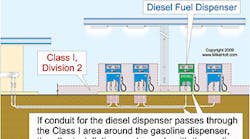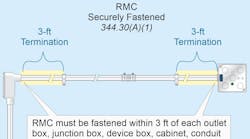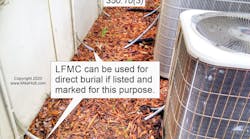All questions and answers are based on the 2008 NEC.
Q. How does the Code address diesel fuel dispensers as they relate to hazardous locations?
A. The hazardous Class I location requirements contained in Art. 514 only apply where a flammable liquid having a flash point below 100°F [Art. 100 Volatile Flammable Liquid] is stored, handled, or dispensed [514.3(B)]. The flash point of diesel fuel is 100°F or above; thus, the area involving diesel fuel is typically not a classified location. But if the conduit for the diesel dispenser passes through the Class I area around the gasoline dispenser, then the installation must comply with the sealing and wiring method requirements of Art. 501 ( Figure ).
Q. Can a receptacle be installed above a suspended ceiling?
A. Receptacles are permitted above a suspended ceiling, but a flexible cord is not [400.8(5)]. Why install a receptacle above a ceiling if the flexible cord is not permitted in this space? Because the receptacle can be used for portable tools, it just can't be used for cord-and-plug-connected equipment fastened in place, such as a projector.
Q. Can a 3-way switch be used as a generator transfer switch for a single circuit in a house?
A. Transfer equipment must be suitable for the intended use and designed/installed to prevent interconnection of the utility and generator supply [702.6]. According to the UL White Book (category QJQR), “snap switches have not been investigated for switching a load between two alternate sources of supply.” Therefore, 110.3(B) would prohibit using a 3-way switch for transfer equipment.
Q. Can a light fixture and its associated wiring be mounted to a tree?
A. Trees can be used to support luminaires [410.36(G)], but they must not be used to support overhead conductor spans [225.26].
Q. Where does the Code require removal of line voltage conductors and raceways that are no longer in use?
A. Abandoned line voltage conductors are only required to be removed in cellular concrete floor raceways [372.13], cellular metal floor raceways [374.7], underfloor raceways [390.7], and information technology equipment [640.5(F)].
Q. Can service conductors go directly to a transfer switch, without a disconnect upstream of the transfer switch?
A. Electrical equipment must not be connected to the supply side of the service disconnect enclosure, except for the equipment listed in 230.82, which does not include transfer switches. If the transfer switch is the service disconnect and is marked as “suitable for use as service equipment” [230.66], it can be used as the service disconnect, which complies with this rule.
Q. I am remodeling an existing commercial building that has Type NM cable installed above the suspended ceiling. With this in mind, can I also install new Type NM cable above the suspended ceiling?
A. Type NM cable isn't allowed to be exposed in dropped or suspended ceilings in other than one-family, two-family, and multifamily dwellings [334.12(A)(2)]. Although this was allowed in many buildings under previous Code editions, you must comply with this rule now that it is no longer permitted.
Copyright 2009 by Penton Business Media Inc. All rights reserved.





